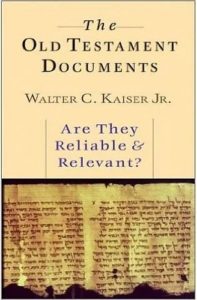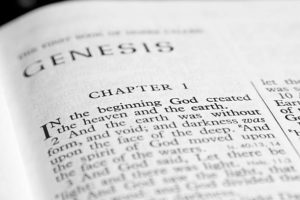Jan
23
Genesis and the Battle between Tehom and Tiamat

The Bible has long been the target of pagans, skeptics, and “progressives”, including various attacks on the reliability of the text. When it comes to the Old Testament, they (naturally) start in the beginning with the book of Genesis, particularly (but not limited to) the first few chapters. In his book The Old Testament Documents, Dr. Walt Kaiser addresses several such critiques, including those made by German scholar Hermann Gunkel in the late-19th century.
The events in Genesis, in Gunkel’s estimation, were not actual events in space/time. Rather, they serve as a “legendary age” upon which the subsequent narrative of Israel rests. One way in which Gunkel challenged the historical reliability of Scripture was essentially by claiming that “Genesis 1-11 reflects borrowing from other ancient Near Eastern mythologies, mythologies that rest in the ‘imagination of the raconteurs,’ while history must be traced back to the first-hand evidence.” Below, I have reproduced Kaiser’s description of the “evidence” presented by Gunkel and others, along with the counterarguments.
— — —
“The charge that Genesis 1-11 is derivative of other mythologies is a hard one to deal with, since it depends on so many subjective criteria — even more than those we have already dealt with. We shall assume for the purposes of discussion that what was intended here [by Gunkel] were references to certain alleged mythological motifs in the text.
One of the earliest candidates as a source for such borrowing was the struggle between the chief deity of a region and the chaos monster. In Genesis it was said that the conflict was between Yahweh and the “deep”. Now tehom, the “deep,” was thought by most scholars to be a somewhat purged reference to Tiamat. In the Babylonian epic of creation, called the Enuma Elish (“When above…”), the chief god to emerge in Babylon, Marduk, slew the dragon Tiamat, a personification of the sea and watery depths. He sliced her in half and fashioned one half of her into the “sky” with its “upper sea,” while with the other half he formed the “lower sea” on which he rested the earth.
Nowhere have scholars banked more heavily on the equation of one word, “the deep,” for linking a Genesis story with a Babylonian background. Ever since Gunkel argued in 1895 that tehom, “deep, ocean, sea,” in Genesis 1:2 retained vestiges of Babylonian mythology, it has been popular to claim that there was a direct relationship between tehom and the Babylonian goddess Tiamat…. There were many others who joined in the chorus, but the point always was the same: the Genesis creation story had to be derived from mythological sources due to the philological similarities between “deep” and Babylonian Tiamat.

The difficulty with borrowing a feminine Babylonian word and bringing it over into Hebrew unaugmented by any sufformative elements, and locating a guttural letter “h” (Hebrew he) in the middle of the word, has never been explained, argued Alexander Heidel as long ago as 1951. However, Heidel’s careful work is seldom answered or factored into the more pervasive allegiance to the view that tehom is derived from Babylonian Tiamat. Kenneth Kitchen [1966] added his voice to Heidel’s when he observed that the equation of these two terms was a “complete fallacy.” Kitchen went on to note that the rule in the ancient Near East was to build legends and myths out of simple accounts and traditions, by way of accretion and embellishment, rather than the other way around. Accordingly, one only need remember that tehom shares a common Semitic root that also appears in the Canaanite texts from Ugarit as thm, meaning “sea” or the like, as early as the second millennium B.C.
Nahum Sarna [1966] had attempted to mount a response to Heidel’s complaint by noting that: (1) while tehom is not feminine in grammatical form, it does frequently employ a feminine verb or adjective, (2) tehom has the characteristics of a proper name in that it is used without the definite article, and (3) Genesis 19:25; Deuteronomy 33:13 and Habakkuk 3:10 place tehom in poetic address and have tehom “crouching” and “crying out.” However, John Skinner [1904] had anticipated all three arguments when he had previously noted that (1) tehom is “confined to poetry (except Gen 1:2; 7:11; 8:2; Deut 8:7; Amos 7:4)”; (2) the invariable absence of the definite article (except with plural in Ps 106:9 and Is 63:13) may point to the fact that it is a proper name, but not that it is a personification; and (3) the admittedly clear references to personification are in the poetic passages of Genesis 49:25 and Deuteronomy 33:13.
One more argument might be added here, since this equation of the “deep” with Tiamat is the anchor on which so much of the case for Babylonian borrowing for the creation story in the Bible hangs. Canaan is the more natural environmental context from which any contest with the sea (the god Marduk or Yam) or sea goddess might arise because of its proximity to the Mediterranean Sea. Indeed, Thorkild Jacobsen [1968] had argued that Marduk means “son of the storm”; therefore his conflict with Tiamat was a battle with the elements: the god of the storm, rain, lightning and thunder versus the goddess of the sea. That is the same myth that arose in the middle of the second millennium in Canaan in the Ugaritic myth of Baal versus Yam, “sea.”

Thus, it is now a question as to who borrowed from whom? Jacobsen concluded that the myth originally arose in Canaan and the borrowing was just the reverse of what we had always envisioned in scholarship: the east Semite Babylonians had borrowed it from the west Semites of Canaan. Moreover, this would make more philological sense assuming that Babylonian tiamat came from tihamatum, whereas the reverse process raised all the philological objections we have already heard. It was J.V. Kinnier Wilson [1958] who finally put the whole issue into perspective when he warned:
“The theory that Hebrew Genesis is genetically related to the Babylonian has long been held… and has relied to a large extent on the much publicized equation of Tiamat with the Hebrew tehom, ‘the deep.’ It is now, however, recognized that since the two words have different meanings… it is of no importance whether they are etymologically connected or not…. [T]he epic has no connections of any kind or at any point with Genesis.”
… The concept of a personified Tiamat who is a mythical antagonist to Marduk never even comes close to being behind the notion of tehom in Genesis 1:2. Instead, tehom is just part of God’s creation, inanimate, unpersonified and nonresistant to God’s work of creating.”
— — —
I’m no expert in this stuff, but it appears that Gunkel’s theory has been roundly and soundly disproven. Those who insist on clinging to such arguments in the face of the facts just embarrass themselves.















